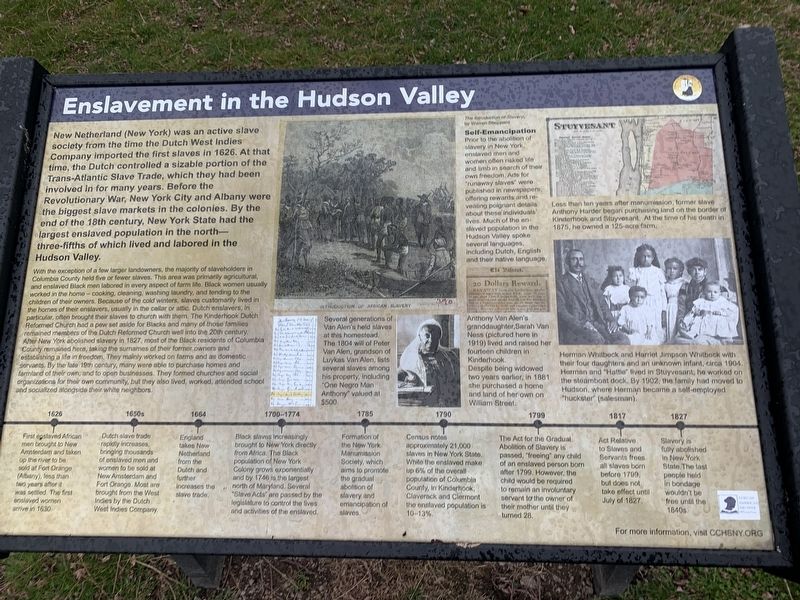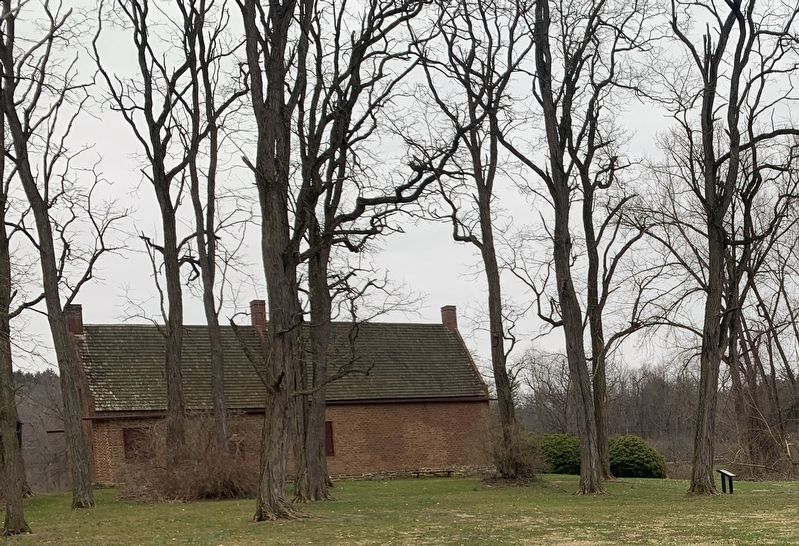Near Kinderhook in Columbia County, New York — The American Northeast (Mid-Atlantic)
Enslavement In The Hudson Valley
Enslavement in the New Netherland (New York) was an active slave society from the time the Dutch West Indies Company imported the first slaves in 1626. At that time, the Dutch controlled a sizable portion of the Trans-Atlantic Slave Trade, which they had been involved in for many years. Before the Revolutionary War, New York City and Albany were the biggest slave markets in the colonies. By the end of the 18th century, New York State had the largest enslaved population in the north- three-fifths of which lived and labored in the Hudson Valley.
With the exception of a few larger landowners, the majority of slaveholders in Columbia County held five or fewer slaves. This area was primarily agricultural, and enslaved Black men labored in every aspect of farm life. Black women usually worked in the home-cooking, cleaning, washing laundry, and tending to the children of their owners. Because of the cold winters, slaves customarily lived in the homes of their enslavers, usually in the cellar or attic. Dutch enslavers, in particular, often brought their slaves to church with them. The Kinderhook Dutch Reformed Church had a pew set aside for Blacks and many of those families remained members of the Dutch Reformed Church well into the 20th century. After New York abolished slavery in 1827, most of the Black residents of Columbia County remained here, taking the surnames of their former owners and establishing a life in freedom. They mainly worked on farms and as domestic servants. By the late 19th century, many were able to purchase homes and farmland of their own, and to open businesses. They formed churches and social organizations for their own community, but they also lived, worked, attended school and socialized alongside their white neighbors.
Several generations of Van Alen's held slaves at this homestead The 1804 will of Peter Van Alen, grandson of Luykas Van Alen, lists several slaves among his property, including “One Negro Man Anthony” valued at $500.
Self-Emancipation
Prior to the abolition of slavery in New York enslaved men and women often risked life and limb in search of their own freedom. Ads for runaway slaves were published in newspapers offering rewards and revealing poignant details about these individuals. Much of the enslaved population in the Hudson Valley spoke several languages including Dutch, English and their native language.
Less than ten years after manumission, former slave Anthony Harder began purchasing land on the border of Kinderhook and Stuyvesant. At the time of his death in 1875, he owned a 125-acre farm.
Anthony Van Alen's granddaughter, Sarah Van Ness (pictured here in 1919) lived and raised her fourteen children in Kinderhook. Despite being widowed two years earlier, in 1881 she purchased a home and land of her own on William Street
Herman Whitbeck and Harriet Jimpson Whitbeck with their four daughters and an unknown infant, circa 1904. Herman and "Hattie lived in Stuyvesant, he worked on the steamboat dock. By 1902, the family had moved to Hudson, where Herman became a self-employed “huckster” (salesman).
[Timeline:]
1626
First enslaved African men brought to New Amsterdam and taken up the river to be sold at Fort Orange(Albany), less than two years after it was settled. The first enslaved women arrive in 1630.
1650s
Dutch slave trade rapidly increases bringing thousands of enslaved men and women to be sold at New Amsterdam and Fort Orange. Most are brought from the West Indies by the Dutch West Indies Company.
1664
England takes New Netherland from the Dutch and increases the slave trade.
1700-1774
Black slaves increasingly brought to New York directly from Africa The Black population of New York Colony grows exponentially and by 1740 is the largest north of Maryland. Several "Slave Acts” are passed by the legislature to control the lives and activities of the enslaved.
1785
Formation of the New York Manumission Society, which aims to promote the gradual abolition of slavery and emancipation of slaves.
1790
Census notes approximately 21,000 slaves in New York State. While the enslaved make up 6% of the overall population of Columbia County, in Kinderhook, Claverack and Clermont the enslaved population is 10-13%.
1799
The Act for the Gradual Abolition of Slavery is passed, "freeing any child of an enslaved person born after 1799. However, the child would be required to remain an involuntary servant to the owner of their mother until they turned 28.
1817
Act Relative to Slaves and Servants frees all slaves born before 1700 but does not take effect until July of 1827.
1827
Slavery in fully abolished in New York State. The last people held in bondage wouldn't be free until the 1840s.
Erected by Columbia County Historical Society.
Topics. This historical marker is listed in these topic lists: Abolition & Underground RR • African Americans • Civil Rights • Industry & Commerce. A significant historical month for this entry is July 1827.
Location. 42° 22.859′ N, 73° 41.503′ W. Marker is near Kinderhook, New York, in Columbia County. Marker can be reached from New York State Route 9H, 0.2 miles north of Fischer Road, on the right when traveling south. Marker can be reached from the Ichabod Crane Schoolhouse parking lot. Touch for map. Marker is at or near this postal address: 2589 Route 9H, Kinderhook NY 12106, United States of America. Touch for directions.
Other nearby markers. At least 8 other markers are within walking distance of this marker. Washington Irving (a few steps from this marker); Black Locust Trees (within shouting distance of this marker); Native Inhabitants (within shouting distance of this marker); Colonial Dutch Houses (1690-1750) (within shouting distance of this marker); Early Dutch Settlers (within shouting distance of this marker); Immigrant Farmers (within shouting distance of this marker); Eleanor Roosevelt at Ichabod Crane (within shouting distance of this marker); One-Room Schoolhouses (about 300 feet away, measured in a direct line). Touch for a list and map of all markers in Kinderhook.
Also see . . . Slavery in New York (Wikipedia). (Submitted on April 1, 2024, by Steve Stoessel of Niskayuna, New York.)
Credits. This page was last revised on April 1, 2024. It was originally submitted on March 30, 2024, by Steve Stoessel of Niskayuna, New York. This page has been viewed 74 times since then. Photos: 1. submitted on March 30, 2024, by Steve Stoessel of Niskayuna, New York. 2. submitted on April 1, 2024, by Steve Stoessel of Niskayuna, New York. • Devry Becker Jones was the editor who published this page.

